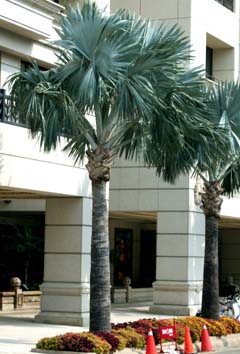Bismarckia nobilis sp. silver Information
A solitary, large, drought tolerant, slow growing, dioecious palm. Common in cultivation, and common in the wild. It has a smooth, grey-brown trunk, 18.3 m. (60 ft.) tall, 35.6 cm. (14 inch) diameter with no obvious leaf scars, and huge segmented, palmate (fan) leaves, 3 m. (10 ft.) long, 1.5 m. (5 ft.) wide, bluish-sliver above and beneath.
Leaves: Costapalmate, 1.5 diameter at greatest width, 13-30 leaves in the crown, very occasionally green usually densely covered in white wax and patches of reddish. Note: This, the silver form being the most common should be the true type form, the green form should be the unusual type form).
Bismarckia nobilis sp. silver can tolerate freezing temperatures to about -3.8°C (25°F). It naturally occurs in arid, open, sun exposed, montane locations, and should be planted to maximise sunshine exposure. Under extreme freezing conditions we recommend you keep this palm as dry as possible. It should be noted that in its natural habitat the temperature swings between extreme heat and extreme cold occur within 12 hours (night & day) of a single day, and have little to do with Summer/Winter seasons. Therefore, this palm dislikes long durations of cold weather and may require additional heat or protection during the coldest weather.
General Information:
The silver form, selected from high elevation, in arid, southerly provenances of Madagascar can display a greater hardiness to cold. However, this palm is slow to resume growth after a cold spell, and any prolonged temperature greater than -3.5°C is fatal.
A handsome palm, which does well in the drier tropics and subtropics and is planted in many countries. The genus is named after the German chancellor; Otto von Bismark (1815-1898). When Madagascar was colonized by the French, they temporarily included the species in Medemia.
Distribution:
Native to, Madagascar
Almost certainly the most common palm in Madagascar. Often the only tree in the landscape; occasionally planted in E. Madagascar as well. This species is one of the few benefiter's of the mass forest clearings in the West of the Island, and has become more abundant and widespread on the regularly burnt grassland; rarely mixed with Hyphaene. Habitat includes; Plateaux, plains, in all terrains. Sometimes in flooded areas. Conservation status: Not threatened. Widespread and very common.
Location: Madagascar (-19.311144°N, 46.362305°E)
Observations
Bismarckia nobilis sp. silver Overlay Image ©2025 Trebrown - No re-distribution without permission.

